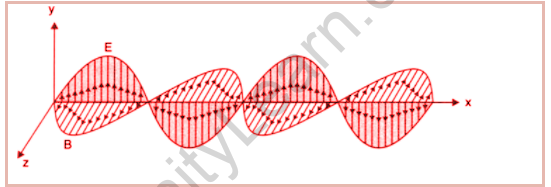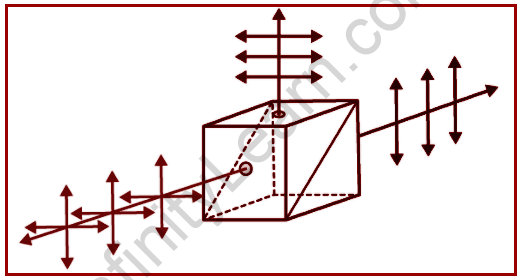
Courses

By Shailendra Singh
|
Updated on 20 Nov 2024, 14:46 IST
Electromagnetic waves, which are synchronized oscillations of electric and magnetic fields that transmit the speed of light, which is generally expressed as “c” in a vacuum, are naturally present in EM radiation. The oscillations of the two fields generate a transverse wave in a standardized, isotropic medium because they are perpendicular to each other and to the direction of energy and wave transmission. A sphere is the wavefront of electromagnetic waves produced by a point source (such as a light bulb).
The frequency of oscillation can be used to define the point of an electromagnetic wave inside the electromagnetic band. Faraday’s electromagnetic induction states that a changing magnetic field at a given place produces an electric field at the same spot over time. In nature, there is symmetry (i.e., a changing electric field with time at a place yields a magnetic field at that point), as Maxwell pointed out. It means that a change in one field (electric or magnetic) over time induces a change in another field.
Maxwell came to the conclusion that electromagnetic disturbances in space are caused by variations in electric and magnetic fields that are perpendicular to each other. These disturbances have wave-like qualities and travel through space without the use of any physical medium. Electromagnetic waves are the name for these waves.
The information about electromagnetic waves and electromagnetic waves’ transverse nature from various physics-related articles are available here. The Traverse nature of electromagnetic waves and their general concept are important topics in physics. Students who want to flourish in physics need to be well known about electromagnetic waves and their traversal nature to get deep knowledge about them to do well on their exams. The definition and information regarding traverse nature are provided here to assist students in effectively understanding the respective topic. Continue to visit our website for additional physics help.
Self-sustaining oscillations in open space or vacuum are known as electromagnetic waves. Because electromagnetic waves of different frequencies have diverse origins and effects on matter, they are given different names. Microwaves, radio waves, visible light, ultraviolet radiation, infrared radiation, X-rays, and gamma rays are listed in sequence of increasing frequency and decreasing wavelength. Electrically charged particles undergoing acceleration produce electromagnetic waves, which can interact with other charged particles and exert force on them. Electromagnetic waves convey energy, motion, and angular momentum away from their originating particle and can impart these magnitudes to matter.
Vibrations between an electric field and a magnetic field cause electromagnetic waves to be produced. The process of electromagnetic waves forming is fascinating. A magnetic field is created around the periphery of a charged particle in motion. The direction of the magnetic field varies depending on the type of charge. The magnetic field produced by a positive charge is in the opposite direction as the magnetic field produced by a negative charge.
The reaction of a portable AM radio to a broadcasting station demonstrates the fact that electromagnetic waves are polarised. The electric part of the signal is received by an AM radio with a telescopic antenna. The signal is considerably reduced when the antenna is oriented horizontally. Some portable radios contain horizontal antennas (typically inside the radio casing) that are sensitive to the electromagnetic wave’s magnetic component. In order to receive the signal, such a radio must remain horizontal. In such instances, responsiveness is also influenced by the radio’s direction in relation to the station.
Electromagnetic waves are important in technology because of their ability to transport energy from one location to another. Broadcasting stations’ radio and television broadcasts carry energy. Light transports energy from the sun to the earth, allowing life to exist on the planet.

Electromagnetic waves can be classified based on the direction of disruption and the frequency range in which they occur. Remember that a wave is a form of energy transmission from one place in space to another. When the wave’s disturbances are perpendicular (at right angles) to the wave’s propagation path, it’s called a transverse wave. Transverse waves are electromagnetic waves. That is, the electric and magnetic fields oscillate (alter) in a plane perpendicular to the wave’s propagation path. In an EM wave, the electric and magnetic fields are also perpendicular to one another. In an EM wave, the electric and magnetic fields (E and B) are perpendicular to each other and to the wave’s propagation direction.

The direction of change has some freedom since electric and magnetic fields change in a plane (perpendicular to the path of wave propagation).
The electric and magnetic field vectors of an electromagnetic wave are perpendicular to each other and to the wave’s propagation direction at the same time. Transverse nature is the name given to this type of electromagnetic wave.
In the direction of wave propagation, both the electric and magnetic fields are perpendicular to each other, according to Maxwell. He imagined a positive x-axis electromagnetic wave propagating. The electric and magnetic fields propagate sinusoidally with the x-axis and are independent of the y and z-axes when a rectangular parallelepiped is placed parallel to the three coordinate axes.

Because there is no charge inside the rectangular parallelepiped, the total electric flow across it must be zero. Gauss’ law is the name given to this law.
∮ Eds=0
The electric field stays unchanged at various positions along the x-axis, indicating that it is static in nature. It is well understood that static fields can propagate as waves, thus
Ex=0
Because the electric field is perpendicular to the wave propagation path, the component of the electric field along the propagation direction is zero.
This is also true for a magnetic field because the magnetic field is perpendicular to the wave propagation direction. This demonstrates the electromagnetic wave’s transverse nature with respect to the wave propagation direction.
What demonstrates the electromagnetic wave’s transverse nature with respect to wave propagation direction?
Because the electric field is perpendicular to the wave propagation path, the component of the electric field along the propagation direction is zero.
This is also true for a magnetic field because the magnetic field is perpendicular to the wave propagation direction. This demonstrates the electromagnetic wave’s transverse nature with respect to the wave propagation direction.
Self-sustaining oscillations in open space or vacuum are known as electromagnetic waves. Vibrations between an electric field and a magnetic field cause electromagnetic waves to be produced.
The electric and magnetic field vectors of an electromagnetic wave are perpendicular to each other and to the wave's propagation direction at the same time.